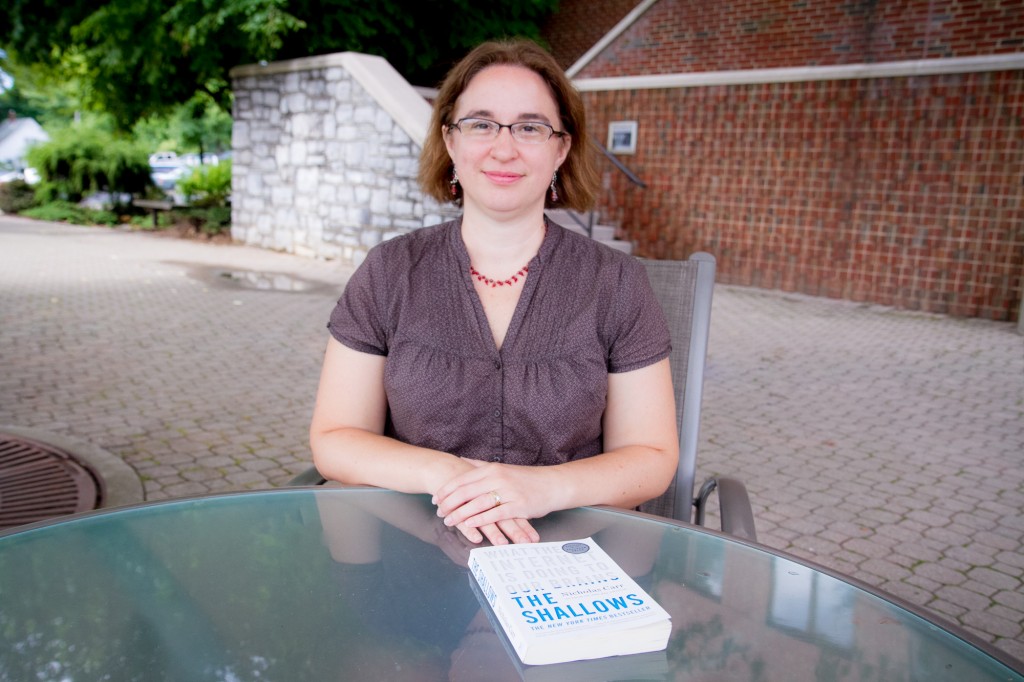Senior Kara Lofton ponders the university’s Common Read program, now in Year 2, after reading the assigned book, The Shallows: What the Internet Is Doing to Our Brains.
I’m big on reading books (no TV at home when growing up) and consider myself decently informed about the university that I’ll be getting a degree from in December, but I had never heard of the Common Read until I was asked to write an EMU news blog about it. Along with the assignment came the 2014-15 Common Read book, The Shallows: What the Internet Is Doing to Our Brains.
The book proved to be fascinating and sobering – ironically, it explains why people of my 18-22 age group and younger would be highly unlikely to actually read all 228 pages of The Shallows. Not unless it was assigned, tested, and graded for credit, or otherwise read under some form of duress.
The idea behind the Common Read – as gathered from national collegiate news accounts and interviews at EMU – is a good one. “Campus common reading programs rest on a simple idea: that reading the same book brings people closer together as a community by creating common ground for discussion,” wrote a commentator at the Association of American Colleges and Universities in 2006.
Breaking out of our narrow circles
Put another way, EMU hopes an interesting book, read by all, can help us to break out of departmental or athletic or musical social circles and meet others. In 2012-13, 309 colleges and universities had common reading programs, with 190 book titles selected, usually centering on themes of social justice, sustainability, diversity, and economic justice, according to a study by the National Association of Scholars.
Here at EMU, for two years in a row, a Common Read book has been selected by our Intellectual Life Committee, consisting of six faculty members from different departments, a couple of student leaders, the campus pastor, a librarian, the provost and the provost’s assistant.
The inaugural book selection for 2013-14 was The Absolutely True Diary of a Part-Time Indian by Sherman Alexie. (I somehow missed this announcement, perhaps because I was on a cross-cultural that fall and at the Washington Community Scholars Center in the spring.) EMU provided all incoming first-year students a free copy of this book, but members of the Intellectual Life Committee interviewed for this article seemed unsure how many students actually read the book.
Several events related to the book were held throughout the year, including Tuesday lunch discussions and Common Grounds sessions, but by all accounts these were not well attended by students.
Students reading books for pleasure?
This may be par for today’s course. A 2007 report on reading habits by the National Endowment for the Arts found that 74% to 80% of college freshmen and seniors read 0–4 books on their own during the school year.
“We were trying to get people to talk to each other,” said chemistry professor Tara Kishbaugh, who is on the Intellectual Life Committee. “We wanted to encourage people to connect with the mission outside of their classes.”
Ashley Thorne, one of the Common Read researchers at the National Association of Scholars, told Inside Higher Ed: “Across the campuses, they aren’t doing the same courses, they’re not reading the same books. So colleges want to give them something common intellectually…. This is a chance to do that.”
Ironically, this year’s Common Read book may offer insights for the poor student participation in the program. In The Shallows, Carr argues that the Internet is rewiring our brains to be efficient in filtering through the vast stores of information available at click of a mouse. But being efficient at filtering information quickly is inhibiting our ability to engage in “deep reading.”
It’s not that people aren’t reading, Carr explains, it is that they are not reading books anymore. People read blogs, online social networks, use newspaper “apps” that give highlights or headlines, and visit Wikipedia for research papers. The nature of information cultivation is changing.
Seven events planned for 2014-15
With the advent of the Internet age, and perhaps demise of the reading one, university scholarship will change dramatically. “This year’s book is far more about what the nature of the university is going to be,” Kishbaugh told me, while last year’s was more about cross-cultural understanding.
Perhaps as the nature of university scholarship shifts, so will the nature of the Common Read until it is a Common Blog or a Common Video Series. If so, I will be among the dinosaur-types who will long for a return to a book, where you can immerse yourself in a well-developed stream of thought and ponder its implications, as I have with The Shallows.
Seven events are planned at EMU for 2014-15 on the themes raised by The Shallows, beginning with a “faculty response” over lunch on Oct. 28 featuring Jerry Holsopple, Walt Surratt, and Dee Weikle in the West Dining Room. The other events and more information about the program can be found here.
